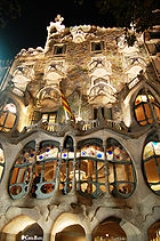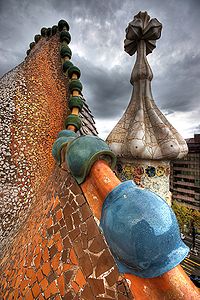
Casa Batlló
Encyclopedia

Antoni Gaudí
Antoni Gaudí i Cornet was a Spanish Catalan architect and figurehead of Catalan Modernism. Gaudí's works reflect his highly individual and distinctive style and are largely concentrated in the Catalan capital of Barcelona, notably his magnum opus, the Sagrada Família.Much of Gaudí's work was...
and Josep Maria Jujol
Josep Maria Jujol
Josep Maria Jujol Gibert was a Catalan architect.Jujol's wide field of activity ranged from furniture designs and painting, to architecture. He worked with Antoni Gaudí on many of his most famous works.-Biography:...
, built in the year 1877 and remodelled in the years 1904–1906; located at 43, Passeig de Gràcia
Passeig de Gràcia, Barcelona
Passeig de Gràcia is both one of the major avenues in Barcelona and also one of its most important shopping and business areas, containing several of the city's most celebrated pieces of architecture. It is located in the central part of Eixample, stretching from Plaça Catalunya to Carrer Gran...
(passeig is Catalan
Catalan language
Catalan is a Romance language, the national and only official language of Andorra and a co-official language in the Spanish autonomous communities of Catalonia, the Balearic Islands and Valencian Community, where it is known as Valencian , as well as in the city of Alghero, on the Italian island...
for promenade or avenue
Avenue (landscape)
__notoc__In landscaping, an avenue or allée is traditionally a straight route with a line of trees or large shrubs running along each, which is used, as its French source venir indicates, to emphasize the "coming to," or arrival at a landscape or architectural feature...
), part of the Illa de la Discòrdia
Illa de la Discòrdia
The Illa de la Discòrdia , is a block on Passeig de Gràcia in the Eixample District of Barcelona, Spain. The block is noted for having buildings by four of Barcelona's most important Modernista architects, Lluís Domènech i Montaner, Antoni Gaudí, Josep Puig i Cadafalch and Enric Sagnier, in close...
(the "Block of Discord") in the Eixample
Eixample
The Eixample is a district of Barcelona between the old city and what were once surrounding small towns , constructed in the 19th and early 20th centuries....
district of Barcelona
Barcelona
Barcelona is the second largest city in Spain after Madrid, and the capital of Catalonia, with a population of 1,621,537 within its administrative limits on a land area of...
, Spain
Spain
Spain , officially the Kingdom of Spain languages]] under the European Charter for Regional or Minority Languages. In each of these, Spain's official name is as follows:;;;;;;), is a country and member state of the European Union located in southwestern Europe on the Iberian Peninsula...
. Gaudí's assistants Domènec Sugrañes i Gras
Domènec Sugrañes i Gras
Domènec Sugrañes i Gras was a Catalan modernist architect and disciple of Antoni Gaudí. He succeeded him at the head of the works of the church of the Sagrada Familia and finished the façade of the Nativity...
, Josep Canaleta y Joan Rubió
Joan Rubió
Joan Rubió i Bellver was a Spanish Catalan architect famous for his contributions to the Catalan Modernist movement...
also contributed to the renovation project.
The local name for the building is Casa dels ossos (House of Bones), as it has a visceral, skeletal
Skeleton
The skeleton is the body part that forms the supporting structure of an organism. There are two different skeletal types: the exoskeleton, which is the stable outer shell of an organism, and the endoskeleton, which forms the support structure inside the body.In a figurative sense, skeleton can...
organic quality. It was originally designed for a middle-class family and situated in a prosperous district of Barcelona.
The building looks very remarkable — like everything Gaudí designed, only identifiable as Modernisme
Modernisme
Modernisme was a cultural movement associated with the search for Catalan national identity. It is often understood as an equivalent to a number of fin-de-siècle art movements, such as Art Nouveau, Jugendstil, Secessionism, and Liberty style, and was active from roughly 1888 to 1911 Modernisme ...
or Art Nouveau
Art Nouveau
Art Nouveau is an international philosophy and style of art, architecture and applied art—especially the decorative arts—that were most popular during 1890–1910. The name "Art Nouveau" is French for "new art"...
in the broadest sense. The ground floor, in particular, is rather astonishing with tracery, irregular oval windows and flowing sculpted stone work.
It seems that the goal of the designer was to avoid straight lines completely. Much of the façade
Facade
A facade or façade is generally one exterior side of a building, usually, but not always, the front. The word comes from the French language, literally meaning "frontage" or "face"....
is decorated with a mosaic
Mosaic
Mosaic is the art of creating images with an assemblage of small pieces of colored glass, stone, or other materials. It may be a technique of decorative art, an aspect of interior decoration, or of cultural and spiritual significance as in a cathedral...
made of broken ceramic tiles (trencadís
Trencadís
Trencadís is a type of mosaic created from broken tile shards. The technique is also called pique assiette.This mosaic is done thanks to broken pieces of ceramic like tiles and cups, for instance.Antoni Gaudí was the first to use this technique...
) that starts in shades of golden orange moving into greenish blues. The roof is arch
Arch
An arch is a structure that spans a space and supports a load. Arches appeared as early as the 2nd millennium BC in Mesopotamian brick architecture and their systematic use started with the Ancient Romans who were the first to apply the technique to a wide range of structures.-Technical aspects:The...
ed and was likened to the back of a dragon
European dragon
European dragons are legendary creatures in folklore and mythology among the overlapping cultures of Europe.In European folklore, a dragon is a serpentine legendary creature. The Latin word draco, as in constellation Draco, comes directly from Greek δράκων,...
or dinosaur
Dinosaur
Dinosaurs are a diverse group of animals of the clade and superorder Dinosauria. They were the dominant terrestrial vertebrates for over 160 million years, from the late Triassic period until the end of the Cretaceous , when the Cretaceous–Paleogene extinction event led to the extinction of...
. A common theory about the building is that the rounded feature to the left of centre, terminating at the top in a turret and cross, represents the lance of Saint George
Saint George
Saint George was, according to tradition, a Roman soldier from Syria Palaestina and a priest in the Guard of Diocletian, who is venerated as a Christian martyr. In hagiography Saint George is one of the most venerated saints in the Catholic , Anglican, Eastern Orthodox, and the Oriental Orthodox...
(patron saint of Catalonia
Catalonia
Catalonia is an autonomous community in northeastern Spain, with the official status of a "nationality" of Spain. Catalonia comprises four provinces: Barcelona, Girona, Lleida, and Tarragona. Its capital and largest city is Barcelona. Catalonia covers an area of 32,114 km² and has an...
, Gaudi's home), which has been plunged into the back of the dragon.

